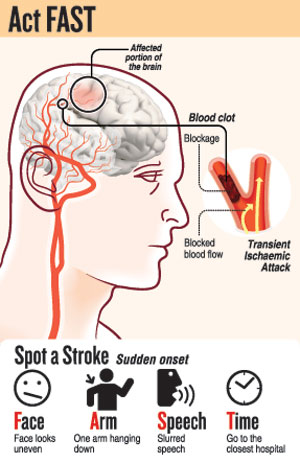TIA: Major warning of stroke
 A transient ischaemic attack (TIA), often called a mini-stroke, is a “major” warning of an impending stroke. A TIA is an emergency.
A transient ischaemic attack (TIA), often called a mini-stroke, is a “major” warning of an impending stroke. A TIA is an emergency.
The risk of recurrent stroke following a TIA is about 10% during the first week, with the highest risk being within the first two days, especially during the first 24 hours.
Eighty percent of the recurrence risk, however, may be reduced with early initiation of effective treatment.
Stroke is a significant burden in Sri Lanka as it is the fourth leading cause of hospital deaths as well as a significant cause of morbidity.
Therefore, the way forward for the country is the improvement of public awareness on early recognition and the establishment of pathways for the rapid delivery of optimal care for TIAs.
What is a TIA?
A TIA is a temporary blockage of blood flow to the brain. When the blood flow to a part of the brain stops for a short period of time, it can mimic stroke-like symptoms.
These symptoms appear and last less than 24 hours before disappearing.
Since these symptoms do not cause permanent damage, many tend to ignore them. This is a big mistake. TIAs may signal a full-blown stroke ahead.
Therefore, if and when you first notice symptoms, getting help immediately is very important.
Does a TIA cause
lasting damage?
Even though a TIA can be troubling, it does not appear to cause lasting damage.
Why?
A TIA occurs because of a blockage in the blood flow to the brain. But the body fights back quickly by pushing the TIA “downstream” or by using natural clot-dissolvers in the blood.
As such, the blockage is not in place long enough to cause lasting damage.
A TIA as a warning for future stroke
A TIA is often called a “mini-stroke” because its immediate consequences are usually harmless. But a “warning stroke” is a better label, because a TIA usually foreshadows a full-blown stroke.
A TIA is caused by a clot or blockage in the brain. The blockage is short term. The clot usually dissolves on its own or gets dislodged and the symptoms usually last five minutes.
The statistics tell part of the story:
A TIA happens before about 15 percent of all strokes.
Up to 25% of people who suffer a TIA die within one year.
About 1/3rd of people who have a TIA go on to have a more severe stroke within one year.
The risk factors for a TIA:
Age
If a person has had a stroke earlier
Smoking
High blood pressure, diabetes and high lipids
Blood clots (emboli) due to atrial fibrillation
When a TIA occurs in a young person with no clear risk factors, the patient might be sent to a neurologist for testing to rule out vasculitis, blood clotting disorders, carotid artery dissection and other uncommon causes of TIA.
Why is a TIA an emergency?
It is an emergency because warning strokes are often followed by more severe strokes. However, up to 80% of this risk is preventable with urgent assessment and treatment
There is a critical need for emergency assessment as the highest risk period is the first 24 hours after a mini-stroke. About half of all recurrent strokes during the 7 days after a TIA occur in the first 24 hours.
What investigations will be
performed?
Imaging of the brain CT/MRI
Imaging of the intracranial and extra-cranial blood vessels using CT angiography/MR angiography, carotid Doppler ultrasound
Investigations such as ECG, FBS, Lipid Profile to check out the risk factors
ECHO and Holter monitoring.
TIA management
The goal of TIA management is to prevent a future stroke.
The medicine and therapy used will depend on the exact cause of the TIA.
If due to a block in a blood vessel – anti-platelet drugs, e.g. aspirin will be administered
If due to atrial fibrillation and emboli – anticoagulation medication e.g. warfarin will be given
High blood pressure, high cholesterol or diabetes will be treated
If a TIA is caused by a blockage in the main artery in the neck (carotid artery) that supplies blood to the brain, procedures such as endarterectomy may be required
Lifestyle changes will be strongly advised – a healthy diet, physical activity, limiting of alcohol intake and stoppage of smoking
As a TIA can signal a future stroke, take the warning seriously and seek medical help immediately.
A TIA offers physicians an opportunity to prevent a stroke. It should be treated as a medical emergency, as up to 80% of strokes after a TIA are preventable.
| The warning signs of a TIA The warning signs of a TIA are the same as a stroke. Beware of the sudden onset of the following: Weakness, numbness or paralysis of one side of your body including face and arms Slurred speech or difficulty understanding others Blindness in one or both eyes Dizziness and headache with no apparent cause It is important to educate yourself on the warning signs of stroke — and do it F.A.S.T. F – Face drooping A – Arm weakness S – Speech slurred T – Time to call for emergency treatment Immediate action needed: If you are worried that you are having a TIA or mini-stroke, get medical help right away. If you think you may have had one in the past, talk to your doctor. | |
(The writer is a Consultant Physician and Head of the Department of Pharmacology, Faculty of Medicine, University of Kelaniya.)


